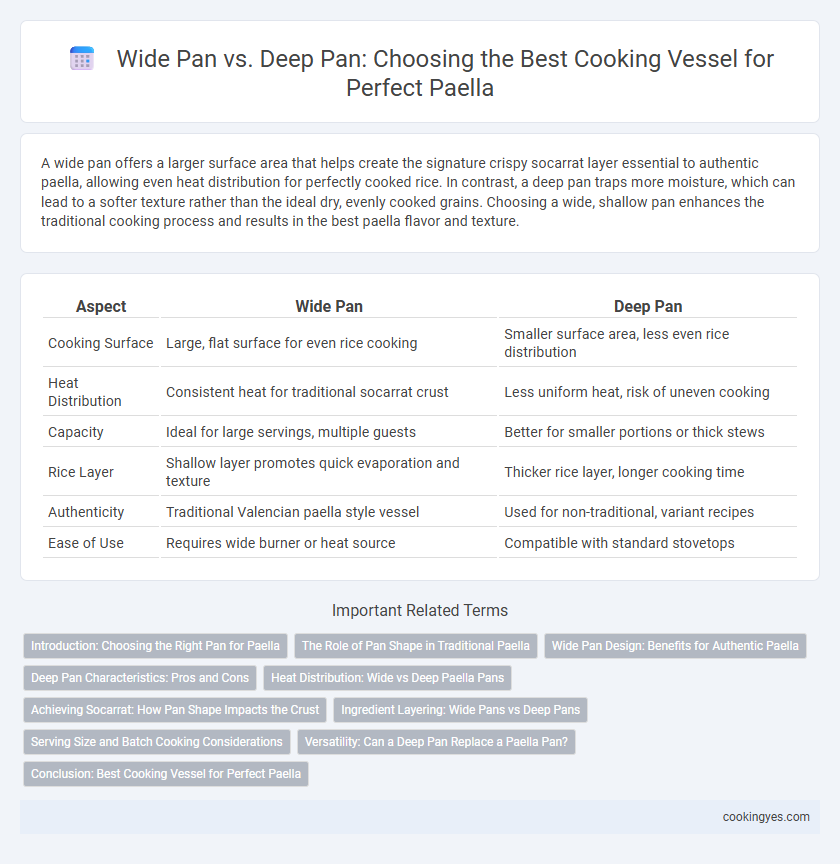A wide pan offers a larger surface area that helps create the signature crispy socarrat layer essential to authentic paella, allowing even heat distribution for perfectly cooked rice. In contrast, a deep pan traps more moisture, which can lead to a softer texture rather than the ideal dry, evenly cooked grains. Choosing a wide, shallow pan enhances the traditional cooking process and results in the best paella flavor and texture.
Table of Comparison
| Aspect | Wide Pan | Deep Pan |
|---|---|---|
| Cooking Surface | Large, flat surface for even rice cooking | Smaller surface area, less even rice distribution |
| Heat Distribution | Consistent heat for traditional socarrat crust | Less uniform heat, risk of uneven cooking |
| Capacity | Ideal for large servings, multiple guests | Better for smaller portions or thick stews |
| Rice Layer | Shallow layer promotes quick evaporation and texture | Thicker rice layer, longer cooking time |
| Authenticity | Traditional Valencian paella style vessel | Used for non-traditional, variant recipes |
| Ease of Use | Requires wide burner or heat source | Compatible with standard stovetops |
Introduction: Choosing the Right Pan for Paella
A wide, shallow pan is essential for authentic paella, as it allows even heat distribution and helps create the prized socarrat crust. Deep pans trap steam, resulting in a more boiled, less crispy texture, which deviates from traditional paella characteristics. Choosing a wide pan made of carbon steel enhances flavor development and ensures optimal cooking performance.
The Role of Pan Shape in Traditional Paella
The shape of the pan plays a crucial role in traditional paella, with wide, shallow pans preferred to ensure even heat distribution and optimal socarrat formation, the prized crispy rice crust. Deep pans hinder proper evaporation of cooking liquid, which disrupts the cooking process and alters the texture of the rice. Authentic Valencian paella is best cooked in a wide, flat pan to maintain balance and flavor intensity characteristic of this iconic Spanish dish.
Wide Pan Design: Benefits for Authentic Paella
A wide pan design is essential for authentic paella, as it ensures even heat distribution and allows the rice to cook uniformly without steaming. This shallow, broad shape facilitates the development of the prized socarrat, the crispy rice crust at the bottom, which is a hallmark of traditional paella. The large surface area also enables better evaporation of liquid, resulting in perfectly textured, fluffy rice that absorbs flavors deeply.
Deep Pan Characteristics: Pros and Cons
Deep pans for paella offer greater capacity for liquid absorption and ingredient layering, enhancing flavor complexity and moisture retention. However, their increased depth can lead to uneven heat distribution, potentially affecting the socarrat--the prized crispy rice layer at the bottom. While deep pans are ideal for larger servings or stews, they may require more careful cooking techniques to achieve traditional paella texture.
Heat Distribution: Wide vs Deep Paella Pans
Wide paella pans offer superior heat distribution due to their low, broad surface area, allowing the rice to cook evenly and develop the characteristic socarrat crust. Deep pans tend to concentrate heat unevenly, risking undercooked rice in the center and overcooked edges. Optimal paella cooking requires a shallow, wide pan to maximize even heat exposure and flavor development.
Achieving Socarrat: How Pan Shape Impacts the Crust
A wide, shallow pan is essential for achieving the perfect socarrat in paella, as its increased surface area allows even heat distribution and promotes the formation of the prized crispy crust. Deep pans trap moisture and steam, which can prevent the rice from drying adequately and inhibit the development of the crunchy bottom layer. Choosing a traditional paella pan with a wide diameter and low sides optimizes contact with heat, ensuring the signature socarrat that defines authentic Valencian paella.
Ingredient Layering: Wide Pans vs Deep Pans
Wide pans allow for a thin, even layer of ingredients that promotes uniform cooking and optimal socarrat formation, enhancing the authentic paella texture. Deep pans cause ingredients to stack, resulting in uneven heat distribution and a less consistent crust, which can affect flavor development. Choosing a wide pan is crucial for layering rice and proteins in a way that maximizes surface contact and traditional taste.
Serving Size and Batch Cooking Considerations
Wide pans are ideal for cooking traditional paella, as their large surface area allows even heat distribution and faster evaporation, resulting in the signature socarrat crust; they typically accommodate serving sizes from 4 to 12 people. Deep pans hold more volume but reduce the rice-to-liquid ratio's effectiveness, often leading to uneven cooking and longer cook times; these pans are better suited for batch cooking larger quantities when serving size exceeds 12. Choosing between wide and deep pans depends on balancing the desired portion size and maintaining authentic texture and flavor in each batch.
Versatility: Can a Deep Pan Replace a Paella Pan?
A deep pan offers versatility by allowing for larger quantities and varied recipes beyond traditional paella, such as stews or braised dishes. While a wide paella pan ensures even heat distribution essential for authentic socarrat development, a deep pan can replace it when flexibility and multi-use cooking are prioritized. However, the depth may hinder the rice's even cooking and caramelization, affecting traditional texture and flavor profiles.
Conclusion: Best Cooking Vessel for Perfect Paella
A wide, shallow paella pan is the best cooking vessel for achieving the authentic socarrat and even heat distribution essential for perfect paella. Its broad surface allows rice to cook uniformly while developing the signature crispy bottom layer. Deep pans trap steam, leading to uneven cooking and a less desirable texture.
Wide Pan vs Deep Pan for Paella cooking vessel Infographic

 cookingyes.com
cookingyes.com